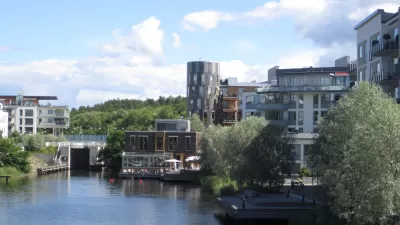One Virginia town's complete streets transformation shows promise for active transportation interventions in small communities.

The term "urbanism" brings to mind big cities and major infrastructure projects, but across the United States, small towns are quietly implementing complete streets projects that improve livability, mobility, and safety for their residents. In Hopewell, Virginia, the success of the city's recent push to improve outdoor recreation shows that small towns can practice urbanism too—sometimes more effectively than larger cities where projects get bogged down in bureaucracy and held back by competing interests.
Taking cues from the National Complete Streets Coalition, Wyatt Gordon writes that Hopewell's leaders are developing a complete streets plan for their city that aims to connect residential and commercial districts, increase available pedestrian infrastructure, and foster more active lifestyles. The initiative, stemming from the city council's 2015 passage of the Healthy Eating, Active Living (HEAL) resolution, has dual goals to facilitate healthier lifestyles for Hopewell residents and to stimulate economic development. City Councilmember Johnny Partin sees benefits in putting health and safety at the core of city projects, saying that investment in pedestrian and bike infrastructure is "essential to making sure everyone can enjoy our streets in safety."
With funding on the way from the Virginia Department of Transportation's (VDOT) Transportation Alternatives Program, Hopewell will be able to complete several other projects, including bikeways that will form part of the Appomattox River Trail and a multimodal path that will "reunite Hopewell's downtown core."
FULL STORY: Hopewell, VA’s complete streets overhaul shows small towns can be urbanist too

Alabama: Trump Terminates Settlements for Black Communities Harmed By Raw Sewage
Trump deemed the landmark civil rights agreement “illegal DEI and environmental justice policy.”

Planetizen Federal Action Tracker
A weekly monitor of how Trump’s orders and actions are impacting planners and planning in America.

The 120 Year Old Tiny Home Villages That Sheltered San Francisco’s Earthquake Refugees
More than a century ago, San Francisco mobilized to house thousands of residents displaced by the 1906 earthquake. Could their strategy offer a model for the present?

Opinion: California’s SB 79 Would Improve Housing Affordability and Transit Access
A proposed bill would legalize transit-oriented development statewide.

Record Temperatures Prompt Push for Environmental Justice Bills
Nevada legislators are proposing laws that would mandate heat mitigation measures to protect residents from the impacts of extreme heat.

Downtown Pittsburgh Set to Gain 1,300 New Housing Units
Pittsburgh’s office buildings, many of which date back to the early 20th century, are prime candidates for conversion to housing.
Urban Design for Planners 1: Software Tools
This six-course series explores essential urban design concepts using open source software and equips planners with the tools they need to participate fully in the urban design process.
Planning for Universal Design
Learn the tools for implementing Universal Design in planning regulations.
Clanton & Associates, Inc.
Jessamine County Fiscal Court
Institute for Housing and Urban Development Studies (IHS)
City of Grandview
Harvard GSD Executive Education
Toledo-Lucas County Plan Commissions
Salt Lake City
NYU Wagner Graduate School of Public Service



























